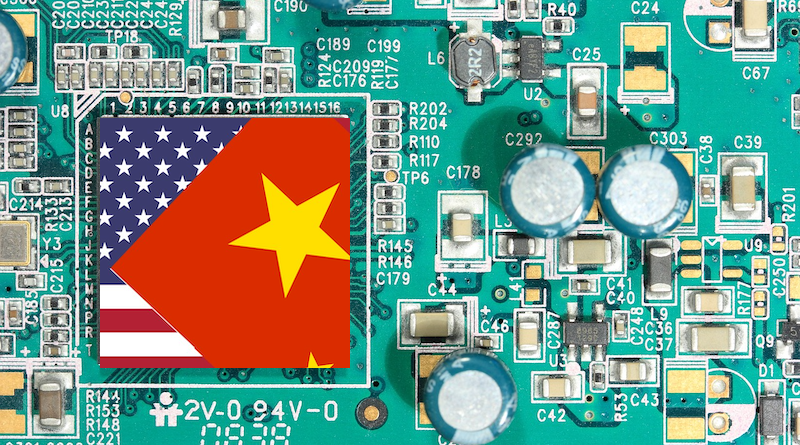Small Powers Caught In The US–China Chips Competition – Analysis
By John Edwards
There was a time when government spending to support particular industries was widely deplored as wasteful interference in free markets. No longer. China, the United States and the European Union have vastly increased government subsidies to industries, frequently supporting the development of advanced technologies. These subsidies are sometimes complemented by policies designed to deny technological innovations to competitor economies.
A report by Global Trade Alert reveals that the three economic superpowers introduced 18,000 industry subsidy programs in the years following the 2008 financial crisis, roughly split evenly. Now in the order of US$361 billion a year, the industry subsidy programs of the big three are collectively bigger than the GDP of four-fifths of the world’s nations. As the international institutions argued, these huge programs pose a particular problem for smaller economies, which cannot begin to match them.
In contrast to earlier protectionist programs for import-competing domestic industries, today’s subsidies are more likely to support industries focused on a global market — particularly high-technology businesses.
Increasingly, subsidy programs are entangled in national security concerns, often justified by a declared requirement to maintain a lead against rival countries or achieve independence from them in new technologies.
While WTO agreements discipline certain subsidies where a harmful effect on competitors can be demonstrated, the new subsidies are often beyond the reach of international agreements.
The most expensive and spectacular example of the new subsidies is the intense battle between the United States and China over advanced chips. Beijing has long been determined to catch up in chip technology, while Washington strives to stay ahead. Both China and the United States now lavishly support the development and production of advanced chips, though neither produces leading-edge chips on their own territory in commercial quantities.
Under programs announced in October 2022, the United States has adopted twin policies of subsidising advanced chip production at home, while arranging with security allies to deny China access to advanced chips and advanced chip-making machinery.
Since the United States does not currently make leading-edge chips or the machinery to produce them, it relies on Taiwan to refuse to make advanced chips for Chinese businesses and the Netherlands to refuse to supply them with advanced chip-making equipment. At the same time, Washington is paying billions of dollars to the Taiwan Semiconductor Manufacturing Company and South Korea’s Samsung to establish advanced chip-making foundries in the United States.
China currently produces 16 per cent of the world’s chips, more than the United States. But it cannot yet produce in quantity the advanced chips the United States is seeking to deny it.
While presented as a denial of one of a ‘narrow set of sensitive technologies’ in the 20 May 2023 G7 communique, it is widely understood that the US objective is to block China’s progress in artificial intelligence technologies. These technologies are already widely used in military applications such as eavesdropping and self-guided drones but, more importantly, hold the possibility of large-scale commercial transformation. As CSIS expert Greg Allen explained in 2022, the US strategy has shifted from slowing the pace of China’s advance to actively seeking to reverse it.
China is not far behind the United States in the number and quality of research publications in artificial intelligence. But Chinese businesses are encountering serious difficulty training large language models of the quality being developed by their US counterparts due to the shortage of advanced chips.
While it is commonly said China is 10 years behind in chip production, there are plausible signs that Chinese businesses can now design advanced chips. Despite having a somewhat smaller economy than the United States, China’s manufacturing value-add is roughly the same size as that of the United States, Germany, Japan and South Korea put together.
The new intensity and lavish scale of industry subsidisation among the economic superpowers, coupled with the entanglement of these programs in national security rationales, pose issues for smaller powers. Australia, for example, cannot begin to match the new levels of industry subsidisation. There is also the considerable risk of being drawn into what is essentially a commercial competition on the US side, to the detriment of Australia’s far bigger economic relationship with China.
There are signs of that already in the Australia–United States minerals pact, signed in May 2023. There are thousands of research cooperation agreements between China and Australia, some of which are at risk, especially if the United States extends its chip denials to other frontier technology areas, as foreshadowed by the Biden administration.
Once dominated by business interests and economic bureaucrats, large areas of industrial policy are now shifting into the realm of national security. The director-general of Australia’s Office of National Intelligence, Andrew Shearer, noted in March 2022 that technology is ‘the centre of gravity in this new geopolitical contest’.
The policymaking apparatus in Canberra has been rearranged to bring a national security lens to bear on what were customarily economic policy decisions. This is evident in departments such as the Treasury, Foreign Investment Review Board and Department of Foreign Affairs and Trade, the enhanced importance of the Office of National Intelligence and the Department of Home Affairs, and the changing focus of the Five Eyes intelligence-sharing group.
About the author: John Edwards is a Senior Fellow at the Lowy Institute and an Adjunct Professor with the John Curtin Institute of Public Policy at Curtin University.
Source: This piece is published by East Asia Forum and is a summary of his recent paper at the Lowy Institute, ‘Chips, subsidies, security, and great power competition’.

